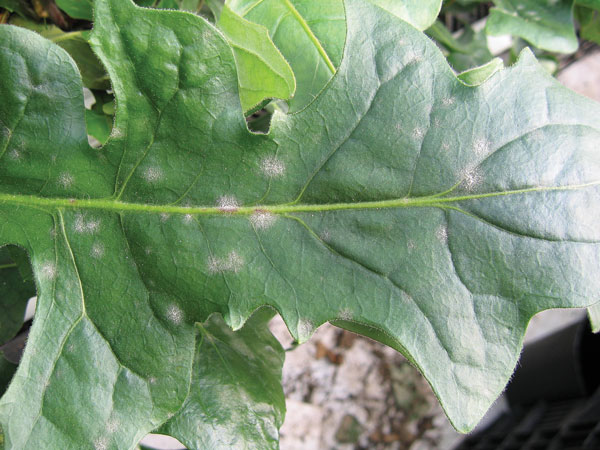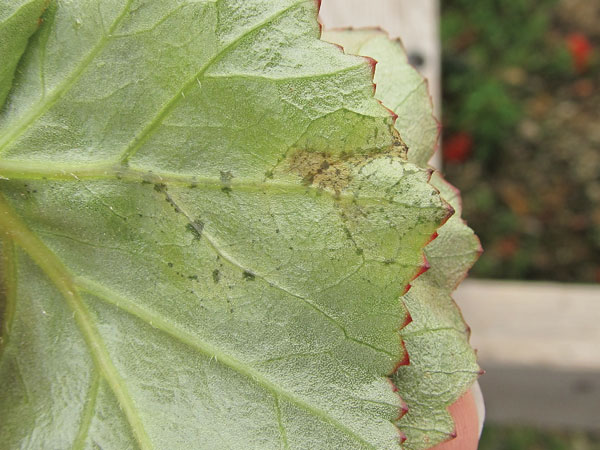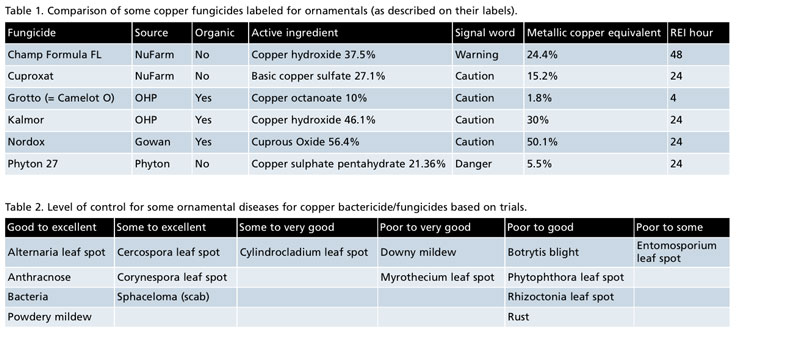1/1/2020
All Coppers Are Not Created Equal
A. R. Chase

Author’s note: About 10 years ago, I reviewed fungicides in six different FRAC groups including FRAC M1 - Copper. The current series will only be three, from copper to Bacillus and finally FRAC 7 fungicides (alone or in combination with another FRAC group). This is the first one.
Copper was one of the first fungicides developed and was used to combat disease of grapevines (like black rot) and fruit (like apple scab). In the 1800s, copper sulfate pentahydrate was formulated with lime into “Bordeaux mix,” which was more effective and safer. Many other types of coppers followed with basic copper carbonate and copper ammonium carbonate first used in 1887, copper oxychloride in about 1900 and cuprous oxide in 1932. Since then, even safer (to the crop) and more effective copper fungicides have been developed, including copper linoleate (Camelot in 1964) and copper hydroxide (Kocide) in 1968.
Pictured: Powdery mildew on gerbera.
Products used on ornamentals currently are primarily Grotto (replaced with Camelot O), Junction (a combination of copper and mancozeb), Kocide 3000 (available as Kalmor) and Phyton 27. Still others are used in some portions of our market, including on greenhouse vegetables and nursery crops.
Copper fungicides are classified as multi-site in their mode of action and act by disruption of many cellular proteins, which results in pathogen death. They’re considered unlikely to develop resistance (probably primarily fungal pathogens). The fact is that copper resistance in bacterial populations exposed to copper has been demonstrated in multiple crops, including ornamentals and vegetables.
Copper is used in various forms as an algaecide, bactericide, fungicide and water treatment. In ornamentals, copper is often thought of as a bactericide only—perhaps due to the fact that there are very few bactericides in our industry. In nurseries, copper fungicides are widely used on leaf diseases due to their relatively low expense and brand spectrum of activity. Mixed infections require broad-spectrum products or tank-mixing.
Use on greenhouse crops is somewhat lower, perhaps due to the higher crop value that can support higher cost fungicides. In addition, the possibility of phytotoxicity with some copper products is less tolerable on a more valuable greenhouse crop. A solution pH of less than 6.5 increases availability of the Cu ion, which can lead to phytotoxicity. Therefore, mixing any copper with acidic products, including Aliette and B-Nine, is not advisable.
 Checking the labels for six copper fungicides shows some differences in their exact copper source, amount of metallic copper equivalent, REI and approved application method. Additionally some of them are organic, which gives them an edge in breadth of use. It’s also important to take note of their REI differences and levels of signal word, which might tell you how safe the formulation is for people and speaks to the necessary safety gear.
Checking the labels for six copper fungicides shows some differences in their exact copper source, amount of metallic copper equivalent, REI and approved application method. Additionally some of them are organic, which gives them an edge in breadth of use. It’s also important to take note of their REI differences and levels of signal word, which might tell you how safe the formulation is for people and speaks to the necessary safety gear.
Pictured: Xanthomonas on begonia.
Signal words are found on pesticide product labels and they describe the short-term toxicity of the formulated pesticide product. Products with the “DANGER” signal word are the most toxic and have to include the word “poison” on their label. Many of the copper products listed in Table 1 have the lowest level of signal word—"Caution.”
On some ornamentals, residue can also be an issue. The residue from a Nordox application looks like ground up red brick to me. Maybe not an issue on some vegetable or nursery crops, but a real deterrent to use on flowering greenhouse crops.
In contrast, other coppers have a noticeable blue residue and still others have no obvious residue. The lowest residue, in general, is seen with applications of Grotto (formerly Camelot O), which also has the shortest REI of only four hours.
I’ve been working on copper for the past 25 years or so. Clearly, copper products are among the most effective for bacterial diseases, including Erwinia soft rot (callas, foliage plants, orchids and poinsettia), Pseudomonas leaf spots (bedding plants, greenhouse vegetables and herbs), and Xanthomonas leaf spots (geraniums, begonias, zinnias, ranunculus and greenhouse vegetables).
For bacteria, the majority of trials resulted in good to excellent control, which I believe is more controlled by the plant susceptibility and weather than form of copper used. Despite being labeled as having a low resistance issue, you must alternate copper products with another MOA when treating bacterial diseases or resistance to the copper will most likely develop. Other examples of rotational products for bacterial diseases include Bacillus (like Triathlon BA and Cease), plant extracts (like EcoSwing or Regalia) and DDAC (KleenGrow).
There are many other uses for copper fungicides that can be found in Table 2. It would have been nice to split these results out across specific copper products, however, this would only have been possible if the products had been compared in side-by-side trials. This hasn’t been done with many of these products (Cuproxat, Champ and Nordox), which could be due to lack of manufacturer interest in such a comparison.
One thing that’s interesting to note is results for a single pathogen across many trials have been quite variable. This is even true when one looks at a single pathogen and a single crop. For instance, control of downy mildew can be poor to very good depending on the plant, the level of disease when treatments start and the safety of the specific copper to that crop. Some diseases are harder to control than others and some plants are more sensitive to a disease than others.
Some of the best fungal pathogen targets for copper fungicides have been leaf spots (like Alternaria, Cercospora, Colletotrichum and Sphaceloma) and powdery mildew. I don’t believe our research would support use of copper fungicides for Botrytis. The tendency of these products to cause phytotoxicity during the winter when sprays dry slowly makes Botrytis sometimes worse after a copper spray than before.
The closely related Sclerotinia blight hasn’t been controlled by copper in our trials. Other targets that seem ill-advised include Phytophthora and Rhizoctonia. In contrast, we’ve seen fair to very good results in some Pythium root rot trials when the products were applied as drenches. Be sure to read labels for use sites and rates. Only Phyton 27 is labeled for drench applications as far as I can tell.
Copper fungicides represent one of the broadest-spectrum groups in our arsenal. If you cannot take the time for a real diagnosis, they can be a good first step since they cover bacteria and many fungal leaf spots. While the MOA grouping indicates a low chance of resistance development, real-world use has demonstrated quick development of copper resistance in bacterial populations. Remember to rotate between active ingredients to minimize resistance development.
Finally, your choice of product may be based on something as simple as REI, appearance of residue or crop safety, or heaven forbid, cost of use. GT

A. R. Chase is a plant pathologist and president of Chase Agricultural Consulting, LLC in Cottonwood, Arizona.